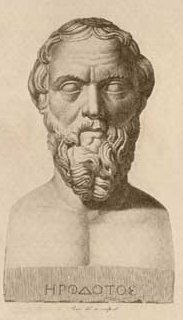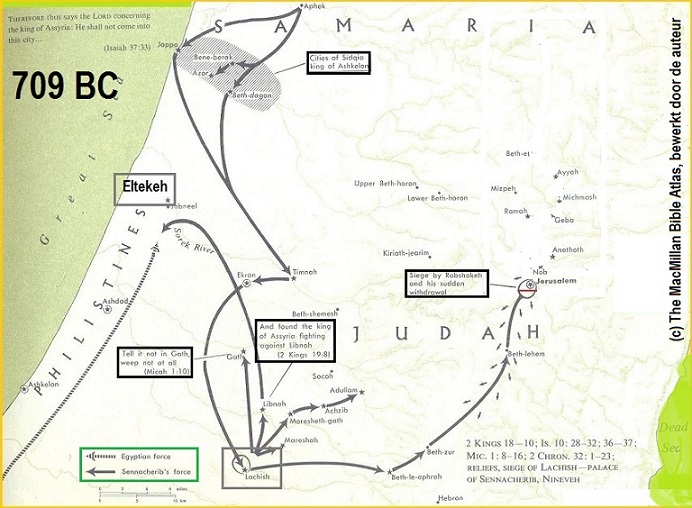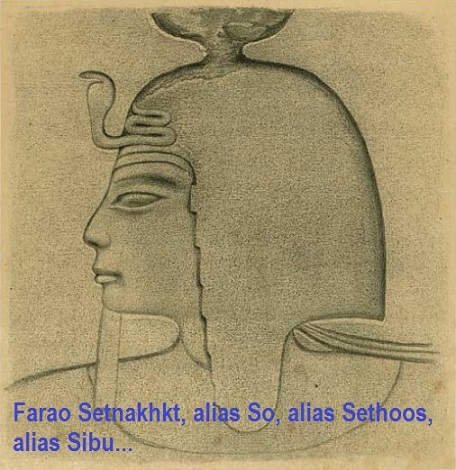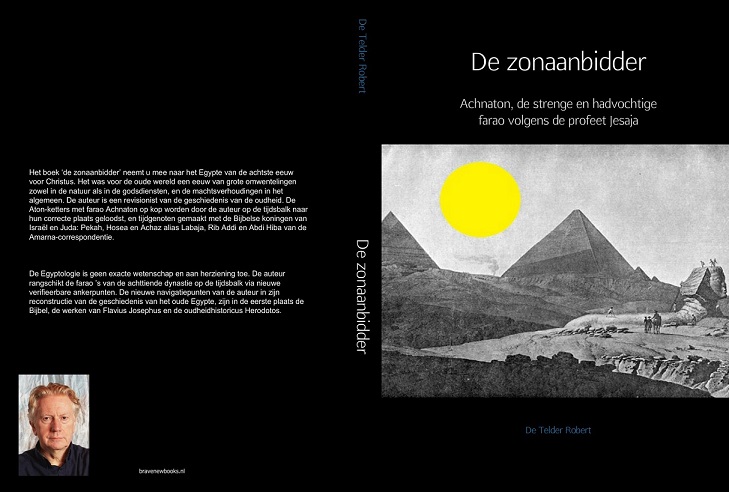Met
onze aflevering van 13.05.2019 op
dit blog behandelden we Herodotos’ ANYSIS, de blinde farao uit de gelijknamige
stad Anysis, die we met Achnaton identificeerden. Zie link: http://bloggen.be/Robertdetelder/archief.php?ID=3158659
Deze
week gaan we verder met het identificeren van de Griekse namen die Herodotos
via zijn faraolijst doorgaf. De farao die Anysis opvolgde kreeg de naam Sethos
van Herodotos.

“Herodotos is mijn naam, ik kom uit Halikarnassos en maak hierbij het
verslag wereldkundig van het onderzoek dat ik heb verricht om de herinnering
aan het verleden levend te houden en de
grootse, indrukwekkende prestaties van de Grieken en andere volken te vereeuwigen.”
De
oudheidhistoricus Herodotos schreef zijn historisch verslag ongeveer tussen de
jaren 450 en 420 voor Chr. De Romeinse staatsman Cicero noemde hem in diens
tijd ‘de vader
der historie’. Halikarnassos, de plaats waar hij geboren werd, lag aan de
zuidwestkust van het huidige Turkije. In Herodotos’ tijd was het een Griekse
kolonie. Herodotos was de eerste classicus die een gedetailleerd verslag over
Egypte neerschreef. Herodotos reisde het gehele land door tot aan de grens met
Nubië. In
mijn boek TIJD en TIJDEN, 2015,
(blz. 43, 310, 345, 371, 375, 385) gaf ik heel wat aandacht aan Herodotos. De
Egyptische koningslijst van Herodotos is niet volledig. Hij vermeldt weliswaar
een bestaande lijst in zijn tijd van 330 koningen (Boek 2:100) die na de eerste
farao Menes over het land regeerden, maar geeft geen namen op. Al die namen
slaat hij over om daarna (Boek 2:102) alle aandacht op Sesostris en diens
opvolgers te richten.
Hierna de
betreffende faraolijst van Herodotos. In de linker kolom staan de Griekse namen
vermeld met rechts hun historische verankering op de tijdsbalk:
Herodotos
Boek: historische verankering op
tijdsbalk:
Sesostris 2
:102 Thothmosis III, Rehabeam – 961
v. Chr.
Feroos/Pheros 2
:111 Amonhotep II – 941
v. Chr.
Proteus 2
:112 Thothmosis IV – 800 v. Chr.
Rampsinitos 2
:121 Amonhotep III – 776 v. Chr.
Cheops 2 :124 piramidebouwer – 8ste eeuw v. Chr.
Chefren 2 :127 piramidebouwer – 8ste eeuw v. Chr.
Mykerinos 2 :129 piramidebouwer – 8ste eeuw v. Chr.
Asychis 2 :136 8ste eeuw v. Chr.
Anysis 2 :137 tijdgenoot Sabakoos – 8ste eeuw v. Chr.
Sethos 2
:141 tijdgenoot Sanherib, Assyrië
– 709 v. Chr.
12 koningen 2 :147 Ramessieden
Psammetichos 2 :152 675
v. Chr.
Neko 2
:158 Neko – 605 v. Chr.
Psammis 2
:159
Apriës 2
:161 Hofra
Amasis 2 :172 525 v. Chr.
De
opvolger van Anysis volgens Herodotos’ faraolijst was Sethos. Hierna het citaat uit Boek 2:
141. After him
(Anysis) there came to the throne the priest of Hephaistos, whose name was Sethos. This man, they said, neglected
and held in no regard the warrior class of the Egyptians, considering that he
would have no need of them; and besides other slights which he put upon them,
he also took from them the yokes of corn-land which had been given to them as a
special gift in the reigns of the former kings, twelve yokes to each man. After
this, Sanacharib king of the
Arabians and of the Assyrians marched a
great host against Egypt. Then the warriors of the Egyptians refused to
come to the rescue, and the priest, being driven into a strait, entered into
the sanctuary of the temple and bewailed to the image of the god the danger
which was impending over him; and as he was thus lamenting, sleep came upon
him, and it seemed to him in his vision that the god came and stood by him and
encouraged him, saying that he should suffer no evil if he went forth to meet the army of the Arabians; for he himself
would send him helpers. Trusting in these things seen in sleep, he took with
him, they said, those of the Egyptians who were willing to follow him, and
encamped in Pelusion, for by this
way the invasion came: and not one of the warrior class followed him, but
shop-keepers and artisans and men of the market. Then after they came, there
swarmed by night upon their enemies mice
of the fields, and ate up their quivers and their bows, and moreover the
handles of their shields, so that on the next day they fled, and being without
defense of arms great numbers fell. And at the present time this king stands in
the temple of Hephaistos in stone, holding upon his hand a mouse, and by
letters inscribed he says these words: "Let him who looks upon me learn to
fear the gods."
Herodotos
beschrijft zijn Sethos als een priester van Hephaistos die na zijn
troonsbestijging de Egyptische militaire kaste niet bijzonder hoog achtte en hun
daarom ondermijnde door bepaalde voorrechten die zij onder de vorige farao ’s
genoten af te nemen. Hij was van mening geen leger nodig te hebben. Daarna
beschrijft Herodotos hoe een nakende Assyrische invasie van Egypte de noodzaak
van een leger duidelijk maakte en hij met een militieleger van vrijwilligers naar
de grens nabij Pelusium optrok. De naam van de Assyrische koning is Sanherib.
Een koning die ook in de Bijbel vermeld wordt en in 709 v. Chr. in het
veertiende regeringsjaar van koning Hizkia van Juda Jeruzalem belegerde maar daar
verslagen werd. Datzelfde jaar trok Sanherib voorafgaand tegen Egypte op.
Farao
Sethos kunnen we ontegensprekelijk in de tweede helft van de achtste eeuw v.
Chr. op de tijdsbalk onderbrengen. De identificatie wordt ook via de
verschillende historische bronnen mogelijk. De veldtocht van Sanherib tegen
Egypte wordt verhaald op diens zogenaamde prismastele die bewaard is gebleven. Een
nederlaag werd op de prismastele niet vermeld, integendeel! Hierna het betreffende citaat:
“…. The officials, nobles, and people of Ekron, who
had thrown Padi their king—bound by oath and curse of Assyria— into fetters of
iron and had given him over to Hezekiah,
the Judahite—he kept him in confinement like an enemy— their heart became
afraid, and they called upon the
Egyptian kings, the bowmen, chariots and horses of the king of Meluhha [Ethiopia], a
countless host, and these came to their aid. In the neighborhood of Eltekeh, their ranks being drawn up
before me, they offered battle. With the aid of Assur, my lord, I fought with them
and brought about their defeat. The
Egyptian charioteers and princes,
together with the Ethiopian king's charioteers, my hands captured alive in
the midst of the battle. Eltekeh and Timnah I besieged, I captured, and I took
away their spoil”.

Sanherib
vermeldt de koningen van Egypte in het meervoud samen met de koning van Ethiopië
die hij bovendien krijgsgevangen nam. Egypte en vooral de Nijldelta was in de
achtste eeuw v. Chr. een lappendeken van dynastieën die ieder over hun deel van
de delta heersten. Een eigennaam geeft Sanherib echter niet op. De
krijgsgevangen Egyptische koningen en prinsen voerde hij mee tot voor de
poorten van Jeruzalem dat onder Assyrische belegering lag. Zij waren daar
getuigen van de ondergang van het Assyrische leger waarbij de Engel des HEEREN
in de Pesachnacht 185.000 Assyrische soldaten vernietigde. Zie het artikel op
dit blog van 04.12.2018, de
Assyrische koning Sanherib chronologisch in lijn met de Bijbelse koning Hizkia
van Juda gebracht, zie link: http://bloggen.be/Robertdetelder/archief.php?startdatum=1543791600&stopdatum=1544396400
Een
Joodse legende leert dat na de vernietiging van het belegerende Assyrische
leger te Jeruzalem de Joden de
volgende morgen het Assyrische bivak binnentrokken en daar de farao van Egypte
en de Ethiopische koning Tirhaka van hun ketenen verlosten, en huiswaarts
zonden.
“…..In view of all the wonders
God had done for him, it was unpardonable that Hezekiah did not feel himself
prompted at least to sing a song of praise to God. Indeed, when the prophet
Isaiah urged him to it, he refused, saying that the study of the Torah, to
which he devoted himself with assiduous zeal, was a substitute for direct
expressions of gratitude. Besides, he thought God's miracles would become known
to the world without action on his part, in such ways as these: After the destruction of the Assyrian army,
when the Jews searched the abandoned camps, they found Pharaoh the king of Egypt and the Ethiopian king Tirhakah. These
kings had hastened to the aid of Hezekiah, and the Assyrians had taken them
captive and clapped them in irons, in which they were languishing when the Jews
came upon them. Liberated by Hezekiah, the two rulers returned to their
respective realms, spreading the report of the greatness of God everywhere. And
again, all the vassal troops in Sennacherib's army, set free by Hezekiah,
accepted the Jewish faith, and on their way home they proclaimed the kingdom of
God in Egypt and in many other lands.”
The Legends of the Jews, Boek
IX,
In mijn boek TIJD
en TIJDEN, 2015, blz. 307-311, breng ik de
aangehaalde historische bronnen samen en lever een historisch plaatje waar de
verschillende puzzelstukjes hun plaats vinden. De Bijbel is hierbij de
leidraad. De farao die de oudheidhistoricus Herodotos met de (Griekse) naam
Sethos doorgeeft is dezelfde persoon als farao (Hebreeuws) So uit de Bijbel.
Het is ook boeiend op te merken wat de buiten-Bijbelse bronnen weglaten, niet
vermelden. We hebben al gezien dat Sanherib nergens melding van zijn nederlaag
maakt. Maar ook Herodotos kreeg van de Egyptische priesters met wie hij over
deze epoque in gesprek ging, niet de volledige waarheid te horen. Zo wordt de
krijgsgevangenneming van de Egyptische en Ethiopische prinsen en edelen op het
slagveld bij Eltekeh door Sanherib niet vermeld. Volgens de eerder geciteerde
Joodse overlevering werd de farao van Egypte waarvan de naam niet wordt
meegedeeld, te samen met de Ethiopische koning Tirhaka door de Joden uit
Jeruzalem van hun ketenen bevrijd en huiswaarts gezonden. Zij waren getuigen
geweest van de vernietiging van het belegerende Assyrische leger voor de
poorten van Jeruzalem. Volgens de Joodse overlevering keerden zij huiswaarts
verkondigende de grootheid van de God van Israël. Maar deze informatie was ten
tijde van Herodotos door de Egyptenaren al lang verwijderd. Wat historisch na
ongeveer 275 jaar voor hen van waarde overbleef was de vermelding van een
veldslag tegen het leger van Sanherib en een standbeeld van de farao die in
zijn hand een muis vasthield met op de sokkel van het beeld een opschrift met
de boodschap om de goden (meervoud) te vrezen.
De bekende wetenschapper Isaac Newton die een revisionist van de geschiedenis van de oudheid
was, schreef ook zijn mening over farao So neer. Volgens Newton was de
Ethiopiër Sabakoos of Sabacon die Herodotos beschreef de Bijbelse farao So. En
mogelijk schrijft Newton, was Sabacon identiek met Sethon of Sethos. Hierna het betreffende gedeelte
dat ik van het internet plukte:
In the Dynasties of Manetho;
Sevechus is made the successor of Sabacon,
being his son; and perhaps he is the Sethon
of Herodotus, who became Priest of Vulcan, and neglected military discipline: for Sabacon is
that So or Sua with whom Hoshea King of Israel conspired against the Assyrians,
in the fourth year of Hezekiah, Anno Nabonass. 24. Herodotus tells
us twice or thrice, that Sabacon after a long Reign of fifty years relinquished
Egypt voluntarily, and that Anysis who fled from him, returned and Reigned
again in the lower Egypt after him, or rather with him: and that Sethon Reigned
after Sabacon, and went to Pelusium against the army of Sennacherib, and was relieved with a great multitude of
mice, which eat the bow-strings of the Assyrians; in memory of which the statue
of Sethon, seen by Herodotus, was made with a Mouse in its hand. A Mouse was
the Egyptian symbol of destruction, and the Mouse in the hand of Sethon
signifies only that he overcame the Assyrians with a great destruction. The
Scriptures inform us, that when Sennacherib invaded Judæa and besieged Lachish
and Libnah, which was in the 14th year of Hezekiah, Anno Nabonass. 34. the King
of Judah trusted upon Pharaoh King of Egypt, that is upon Sethon, and that Tirhakah King
of Ethiopia came out also to fight against Sennacherib, 2 King. xviii. 21.
& xix. 9. which makes it
probable, that when Sennacherib heard of the
Kings of Egypt and Ethiopia coming against him, he went from Libnah towards
Pelusium to oppose them, and was there surprised and set upon in the night by
them both, and routed with as great a slaughter as if the bow-strings of the
Assyrians had been eaten by mice. Some think that the Assyrians were smitten by
lightning, or by a fiery wind which sometimes comes from the southern parts of
Chaldæa. After this victory Tirhakah succeeding Sethon, carried his arms
westward through Libya and Afric to the mouth of the Straits: but Herodotus
tells us, that the Priests of Egypt
reckoned Sethon the last King of Egypt, who Reigned before the division of
Egypt into twelve contemporary Kingdoms, and by consequence before the
invasion of Egypt by the Assyrians.
(THE CHRONOLOGY OF ANCIENT
KINGDOMS AMENDED. A SHORT CHRONICLE from the First Memory of Things in Europe,
to the Conquest of Persia by Alexander the Great, by Sir ISAAC NEWTON, London,
MDCCXXVIII, 1728 AD)
Het boeiende aan de studie van Newton is dat deze
onderzoeker van de achttiende eeuw uitsluitend werkte met het historische
materiaal dat toen voorhanden was via de Bijbel, Flavius Josephus, Herodotos,
Diodorus en andere oudheidhistorici. Het archeologische terrein in Egypte lag
toen nog braak en zou pas voor het Westen toegankelijk worden na de veldtocht
van Napoleon in Egypte in de negentiende eeuw. Maar de eerder vermelde
oudheidhistorici had Newton door en door in de grondtekst bestudeerd en toen al
had hij een revisie van de Egyptische geschiedenis neergepend waar heden heel
wat bruikbare puzzelstukjes in te vinden zijn.
In mijn eerder vermelde studie TIJD en TIJDEN, 2015, blz.
307-311, identificeer ik farao Sethos
van Herodotos met farao Zet van de
drieëntwintigste dynastie van Manetho. Volgens het studiewerk van Donovan A.
Courville (The Exodus Problem and its Ramifications, Chapter XVIII) was de
laatste farao van dynastie XXIII met de naam Zet gelijk aan ‘Sethnakht’ de grondvester van de
twintigste dynastie. Sethnakht was volgens Courville een overgangsfiguur tussen
de twee dynastieën. De orthodoxe Egyptologie heeft niet veel informatie over
deze koning en veel over zijn afkomst en leven wordt gespeculeerd.
Farao ‘Sethos’ van Herodotos wordt opgevolgd door ‘twaalf
koningen’ die ieder voor een tijd over een gebied van Egypte heersten. Later
zou één van hen: farao Psammetichos, de alleenheerschappij overnemen.
Herodotos Boek 2:
147. but I will now recount that which other nations
also tell, and the Egyptians in agreement with the others, of that which
happened in this land: and there will be added to this also something of that
which I have myself seen. Being set free after
the reign of the priest of Hephaistos, the Egyptians, since they could not
live any time without a king, set up
over them twelve kings, having divided all Egypt into twelve parts. These
made intermarriages with one another and reigned, making agreement that they
would not put down one another by force, nor seek to get an advantage over one
another, but would live in perfect friendship: and the reason why they made
these agreements, guarding them very strongly from violation, was this, namely
that an oracle had been given to them at first when they began to exercise
their rule, that he of them who should pour a libation with a bronze cup in the
temple of Hephaistos, should be king of all Egypt (for they used to assemble
together in all the temples). …

De
identificatie van de Sethos van Herodotos met Sethnakht de grondvester van de
twintigste dynastie ligt voor de hand wanneer we in de twaalf koningen van
Herodotos als opvolgers van Sethos, de Ramessieden willen herkennen. Tien
Ramessieden die samen met Necho en Psammetichos de twaalf koningen van
Herodotos uitmaken. Het is een passend puzzelstuk dat men via deze
identificatie kan invoegen.
De orthodoxe Egyptologie heeft
op basis van haar foutieve veronderstelling dat er een dubbele Sothis-kalender
in het oude Egypte in gebruik was, farao Sethnakht in de twaalfde eeuw v. Chr.
geplaatst van 1185 tot 1182 v. Chr. en laat de Ramessieden daarna in
opeenvolging regeren en niet tegelijkertijd zoals Herodotos het doorgaf. Eerder
schreef ik op dit blog op 27.02.2017 een
artikel over de chronologie van het oude Egypte, waarin het gebruik van de
Sothis-kalender weerlegd wordt. Zie link: http://bloggen.be/Robertdetelder/archief.php?startdatum=1488150000&stopdatum=1488754800
Volgens
Herodotos behoren Sethos en de twaalf koningen op de tijdsbalk aan het einde
van de achtste eeuw v. Chr. Dit heeft onder andere tot gevolg dat de invallen
van de zeevolken ten tijde van Ramses III nu ook aan het einde van de achtste
eeuw v. Chr. op de tijdsbalk onder te brengen zijn. De invallen van de
zeevolken en de chronologische revisie gaf ik aandacht in mijn boek ‘De Zonaanbidder, Achnaton de strenge en
hardvochtige farao volgens de profeet Jesaja’, 2016, blz. 149-158, met Appendix
1. Het boek begon ik als inleiding met het beleg van Troje dat gereviseerd nu
aan het begin van de achtste eeuw v. Chr. plaatsvind. De zogenaamde duistere
eeuwen van Griekenland ’s vallen nu weg en krijgen hun historische plaats op de
tijdsbalk. O f hoe belangrijk het
onderzoek van Herodotos’ rangschikking van de farao ’s vanaf Sesostris is.
Wordt
vervolgd…
Met
vriendelijke groet,
Robert
De Telder
Recente publicaties:
Dertig
Jubeljaren, 2018, zie link: https://www.bol.com/nl/p/dertig-jubeljaren/9200000101929798/?suggestionType=searchhistory&bltgh=jLyCAgDUe71UKHV4eLlBLQ.1.7.ProductImage&fbclid=IwAR1FW-GC4SRsGCLFOa0BP_MG9IXEYx3Uo2Ugz3s6x74aPfO0kexdKcN4hqU
Kronieken van
de koningen van Israël, 2017, zie
link: https://www.bol.com/nl/p/kronieken-van-de-koningen-van-israel/9200000086650052/?suggestionType=searchhistory
EXODUS, 2016, zie link: http://www.bravenewbooks.nl/books/102331
Dit boek kan inmiddels volledig online gelezen worden via de volgende link: https://jezusleeft.weebly.com/exodus.html

De Zonaanbidder, 2016, zie link: http://www.bravenewbooks.nl/books/87999
TIJD en TIJDEN, 2015, Zie link: http://boekscout.nl/shop/ViewProduct.aspx?bookId=5579
De Assyriologie
herzien, 2012, zie link: http://www.bravenewbooks.nl/books/76234
De Tweede
Wereldoorlog door de ogen van een neutrale Belg, 2007, zie link: http://www.bravenewbooks.nl/books/69343
Genesis
versus Egyptologie, 2009, dit boek is uitverkocht maar
kan online gelezen worden op de hierna volgende link: http://jezusleeft.weebly.com/genesis-versus-egyptologie.html
Apocalyps, 2009, (dit boek is uitverkocht maar op een PDF-document
gratis op eenvoudig verzoek per email bij de auteur verkrijgbaar)

